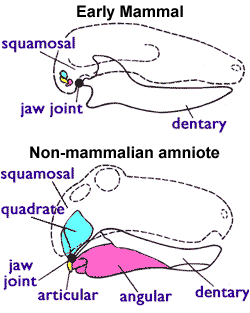Articular bone
The articular bone is part of the lower jaw of most vertebrates, including most jawed fish, amphibians, birds and various kinds of reptiles, as well as Stem-mammal. In these animals it is connected to two other lower jaw bones, the suprangular and the angular. It forms the jaw joint by articulating with the quadrate bone of the skull. [1]


Morganucodontidae had both types of jaw joint: dentary-squamosal (front) and articular-quadrate (rear).
In mammals, the articular bone has migrated to the middle ear to become the malleus, while the quadrate bone becomes the incus. Paleontologists regard this as a defining characteristic of mammalian fossils.[2]
It is analogous to, but not homologous to the articular process of the lower jaw.
See also
References
- ↑ University of the Cumberlands, QUADRATE AND ARTICULAR EXPRESSION
- ↑ "Mammaliformes: Overview - Palaeos". Archived from the original on 2007-04-29.
This article is issued from
Wikipedia.
The text is licensed under Creative Commons - Attribution - Sharealike.
Additional terms may apply for the media files.